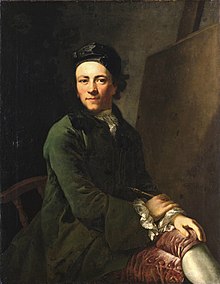Anton Graff
| Anton Graff | |
|---|---|

With the arrival of this self-portrait (1765) on 16 January 1766, in Dresden, Graff's career as one of the most famous portrait artists of the Neoclassicism began
|
|
| Born |
18 November 1736 Winterthur, Swiss Confederacy |
| Died | 22 June 1813 (aged 76) Dresden, Kingdom of Saxony |
| Nationality | Swiss |
| Education | Johann Ulrich Schellenberg, Johann Jacob Haid, Leonhard Schneider |
| Known for | Portrait Painting |
| Notable work | Portrait of Frederick the Great (1781). His masterpiece |
| Movement | Neoclassicism |
| Awards | 1783: Honorary Member of the Akademie der Künste, Berlin, 1812: Honorary Member of the Academy of Fine Arts, Vienna and the Academy of Fine Arts, Munich |
| Patron(s) | Royal Courts of Prussia and Saxony |
Anton Graff (18 November 1736 – 22 June 1813) was an eminent Swiss portrait artist. Among his famous subjects were Friedrich Schiller, Christoph Willibald Gluck, Heinrich von Kleist, Frederick the Great, Friederike Sophie Seyler, Johann Gottfried Herder, Gotthold Ephraim Lessing, Moses Mendelssohn and Christian Felix Weisse. His pupils included Emma Körner, Philipp Otto Runge and Karl Ludwig Kaaz.
Anton Graff was born as the seventh child of the craftsman Ulrich Graff and Barbara Graff née Koller at Untertorgasse 8 in Winterthur, Switzerland (the house does not exist anymore). In 1753 Graff started studying painting at the art school of Johann Ulrich Schellenberg in Winterthur. After three years he left Winterthur for Augsburg. There he worked with the etcher Johann Jakob Haid. However, only one year later he was forced to leave Augsburg. He was too successful. The members of the local painters guild feared his competition. With a letter of recommendation from Johann Jakob Haid, he moved to Ansbach where he found employment with the court painter Leonhard Schneider until 1759. Graff travelled frequently to Munich to study the paintings in the different collections. In 1759 he went back to Augsburg and later moved to Regensburg. In 1765 he went back to Winterthur and Zurich. It was there where he received an invitation from Christian Ludwig von Hagedorn, the newly appointed Director of the recently established Dresden Art Academy, to apply for a post at the Dresden Art Academy. Graff hesitated to do so. He thought he was not good enough to work for the princely court of Saxony. To give Hagedorn an impression of his talent he sent a self-portrait to Dresden. The self-portrait arrived on 16 January 1766, in Dresden. It was so well received that only one day later Hagedorn worked out Graff's employment contract. On 7 April 1766, Graff arrived in Dresden where he was appointed court painter and teacher for portrait painting at the Dresden Art Academy, a post he kept for life although he got better paid offers at other academies, among others in Berlin. In early 1788, the Prussian Minister Friedrich Anton von Heynitz made Graff the financially very attractive offer to work for the Prussian Academy of Arts in Berlin. On 7 May 1789, Graff informed Count Camillo Marcolini, general director of the Dresden Art Academy, about this. Marcolini reacted straight away. On 20 June 1789, Graff was appointed Professor for portrait painting at the Dresden Art Academy.
...
Wikipedia
